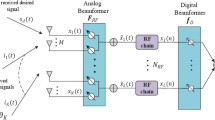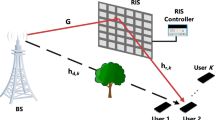Abstract
Emerging 5G communication solutions utilize the millimeter wave (mmWave) band to alleviate the spectrum deficit. In the mmWave range, Multiple Input Multiple Output (MIMO) technologies support a large number of simultaneous users. In mmWave MIMO wireless systems, hybrid analog/digital precoding topologies provide a reduced complexity substitute for digital precoding. Bit Error Rate (BER) and Spectral efficiency performances can be improved by hybrid Minimum Mean Square Error (MMSE) precoding, but the computation involves matrix inversion process. The number of antennas at the broadcasting and receiving ends is quite large for mm-wave MIMO systems, thus computing the inverse of a matrix of such high dimension may not be practically feasible. Due to the need for matrix inversion and known candidate matrices, the classic Orthogonal Matching Pursuit (OMP) approach will be more complicated. The novelty of research presented in this manuscript is to create a hybrid precoder for mmWave communication systems using metaheuristic algorithms that do not require matrix inversion processing. The metaheuristic approach has not employed much in the formulation of a precoder in wireless systems. Five distinct evolutionary algorithms, such as Harris–Hawks Optimization (HHO), Runge–Kutta Optimization (RUN), Slime Mould Algorithm (SMA), Hunger Game Search (HGS) Algorithm and Aquila Optimizer (AO) are considered to design optimal hybrid precoder for downlink transmission and their performances are tested under similar practical conditions. According to simulation studies, the RUN-based precoder performs better than the conventional algorithms and other nature-inspired algorithms based precoding in terms of spectral efficiency and BER.








Similar content being viewed by others
Data Availability Statement
Not applicable.
References
Heath, R. W., Prelcic, N. G., Rangan, S., Roh, W., & Sayeed, A. M. (2016). An overview of signal processing techniques for millimeter wave MIMO systems. IEEE Journal of Selected Topics in Signal Processing, 10, 436–453.
Alkhateeb, A., Leus, G., & Heath, R. W. (2015). Limited feedback hybrid precoding for multi-user millimeter wave systems. IEEE Transactions on Wireless Communications, 14, 6481–6494.
Ayach, O. E., Rajagopal, S., Abu-Surra, S., Pi, Z., & Heath, R. W. (2014). Spatially sparse precoding in millimeter wave MIMO systems. IEEE Transactions on Wireless Communications, 13, 1499–1513.
Elmagzoub, H. M. (2020). On the MMSE-based multiuser millimeter wave MIMO hybrid precoding design. International Journal of Communication Systems, 33, 1–17.
Peng, W. F., Tao, L. L., & Xu, W. Y. (2021). Eavesdropping in the uplink of massive MIMO Countermeasure and performance analysis. AEU: International Journal of Electronics and Communications, 141, 1–9.
Rial, R. M., Rusu, C., Prelcic, N. G., Alkhateeb, A., & Heath, R. W. (2016). Hybrid MIMO architectures for millimeter wave communications: Phase shifters or switches? IEEE Access, 4, 247–267.
Dsouza, K. B., Prasad, K. S. V. N. R., & Bhargava, V. K. (2018). Hybrid precoding with partially connected structure for millimeter wave massive MIMO OFDM: A parallel framework and feasibility analysis. IEEE Transactions on Wireless Communications, 17, 8108–8122.
Wang, Z., Li, M., Tian, X., & Liu, Q. (2017). Iterative hybrid precoder and combiner design for mmwave multiuser mimo systems. IEEE Communications Letters, 21, 1581–1584.
Khan, I., & Henna, S. (2019). An efficient precoding algorithm for mmWave massive MIMO systems. Symmetry, 11, 1–16.
Vizziello, A., Savazzi, P., & Chowdhury, K. R. (2018). A Kalman based hybrid precoding for multi-user millimeter wave MIMO systems. IEEE Access, 4, 2–11.
Kabalci, Y., & Ali, M. (2021). Iterative geometric mean decomposition based secure hybrid precoder design for mmWave massive MIMO communication systems. International Journal of Electronics and Communications (AEU), 135, 1–9.
Elbir, A. M. (2019). CNN-based precoder and combiner design in mmWave MIMO systems. IEEE Communications Letters, 23, 1240–1243.
Nguyen, D. H. N., Le, L.B., & Ngoc, T.L. (2016). Hybrid MMSE precoding for mmwave multiuser MIMO systems. In IEEE International Conference on Communications, pp 1–6.
Heidari, A. A., Mirjalili, S., Faris, H., Aljarah, I., Mafarja, M., & Chen, H. (2019). Harris hawks optimization: Algorithm and applications. Future Generation Computer Systems, 97, 849–872.
Hussien, A. G., Abualigah, L., Zitar, R. A., & Hashim, F. A. (2022). Recent advances in Harris Hawks optimization: A comparative study and applications. Electronics, 111919, 1–50.
Kamboj, V. K., Nandi, A., Bhadoria, A., & Sehgal, S. (2020). An intensify Harris hawks optimizer for numerical and engineering optimization problems. Applied Soft Computing, 89, 1–35.
Tripathy, B. K., Maddikunta, P. K. R., Pham, Q. V., & Gadekallu, T. R. (2022). Harris Hawk optimization: a survey on variants and applications. Computational Intelligence and Neuroscience (pp. 1–22). Hindawi.
Li, S., Chen, H., Wang, M., Heidari, A. A., & Mirjalili, S. (2020). Slime mould algorithm: A new method for stochastic optimization. Future Generation Computer Systems, 111, 300–323.
Manoharan, P., Jangir, P., Ravichandran, S., Alhelou, H. H., Heidari, A. A., & Chen, H. (2021). MOSMA: Multi-objective slime mould algorithm based on elitist non-dominated sorting. IEEE Access, 9, 3229–3248.
Al-Kaabi, M., Dumbrava, V., & Eremia, M. (2022). A slime mould algorithm programming for solving single and multi-objective optimal power flow problems with pareto front approach: A case study of the iraqi super grid high voltage. Energies, 15(7473), 1–33.
Durmus, Ali. (2020). The optimal synthesis of thinned concentric circular antenna arrays using slime mold algorithm. Electromagnetics, 40(8), 541–553.
Yang, Y., Chen, H., Heidari, A. A., & Gandomi, A. H. (2021). Hunger games search: Visions, conception, implementation, deep analysis. Perspectives, and towards performance shifts. Expert Systems with Applications, 177, 1–34.
Al-Kaabi, M., Dumbrava, V., & Eremia, M. (2022). Single and multi-objective optimal power flow based on hunger games search with pareto concept optimization. Energies, 15(22), 8328. 1–31.
Ahmadianfar, I., Heidari, A. A., Gandomi, A. H., Chu, X., & Chen, H. (2021). An efficient optimization algorithm based on Runge Kutta method. Expert Systems with Applications, 181, 1–22.
Devi, R. M., Manoharan, P., Jangir, P., & Elkotb, M. A. (2022). IRKO: An improved Runge-Kutta optimization algorithm for global optimization problems. Computers, Materials & Continua, 70, 4803–4827.
Abualiga, L., Yousri, D., Elaziz, M. A., & Ewees, A. A. (2021). Aquila optimizer: A novel meta-heuristic optimization algorithm. Computers & Industrial Engineering, 157, 1–37.
Zhao, J., Gao, Z. M., & Chen, H. F. (2022). The Simplified aquila optimization algorithm. IEEE Access, 10, 22487–22515.
Mahajan, S., Abualigah, L., Pandit, A., & Altalhi, M. (2022). Hybrid aquila optimizer with arithmetic optimization algorithm for global optimization tasks. Soft Computing, 26, 4863–4881.
Khan, M. R., & Das, B. (2021). Multiuser detection for MIMO-OFDM system in underwater communication using a hybrid bionic binary spotted hyena optimizer. Journal of Bionic Engineering, 18, 462–472.
Acknowledgements
Authors acknowledge the support of the Institute of Technical Education and Research, Siksha ‘o’Anusandhan, Jagamara, Bhubaneswar, and Veer Surendra Sai University of Technology, Burla, Sambalpur, India in terms of E-library and Laboratory for the successful completion of the research work.
Author information
Authors and Affiliations
Corresponding author
Ethics declarations
Conflict of interest
The authors have no competing interests to declare that are relevant to the content of this article.
Additional information
Publisher's Note
Springer Nature remains neutral with regard to jurisdictional claims in published maps and institutional affiliations.
Appendices
Appendix A for HHO
where \(a _1, a _2, a _3, a _4\), and \(q\) are iteratively adjusted arbitrary numbers in between 0 and 1. The variables’ upper and lower limits are displayed as \(\textrm{LB}\) and \(\textrm{UB}\). \({\textbf {F }}_{\mathrm { {\textbf {Brand}}}}\) is a randomly picks hawk from the present population[14].
For soft besiege:
where \(\textrm{J}=2(1-\) rand \(), \Delta {\varvec{ {F}}}_{\mathrm { {\textbf {B}}}}(t )={\varvec{ F}}_{\mathrm { {\textbf {Brabbit}}}}(t )-{\textbf {F }}_{\mathrm { {\textbf {B}}}}(t )\).
For hard besiege:
For soft besiege with progressive rapid dives:
The dimensionality of task is \(\textrm{dim}\) and \({\textbf {S }}\) is a random vector by size \(1 \times \textrm{dim}\) and Levy is the levy flight function.
\(m ,n\) are arbitrary values inside of (0,1), \(\mathrm {\beta }\) has a default value of 1.5.
For hard besiege with progressive rapid dives:
Appendix B for SMA
where \({\textbf {P }}(i )\) belongs to the top half of the population and the value of \(\varphi\) lies in range 0 to 1. \(BF\) and \(WF\) are the best and worst fitness values currently attained, SmellIndex is the order of fitness values sorted in ascending manner [18].
\({\textbf {P }}(i )\) indicates the fitness of \(\overrightarrow{{\textbf {F }}_{\mathrm { {\textbf {B}}}}}\), \(DF\) represents the best fitness measured across all iterations.
where \(\textrm{LB}\) and \(\textrm{UB}\) stand for the search range’s lower and upper limits, respectively.\({\varvec{ F}}_{\mathrm { {\textbf {Ba}}}},{\varvec{ F}}_{\mathrm { {\textbf {Bb}}}}\) represents two individuals selected from the swarm.
Appendix C for HGS
\(\textrm{l}\) is the parameter set as per the experiment, \(\textrm{dim}\) is the dimension of the task and \({\textbf {Hungry }}\) represents the hunger of each entity, \({\textbf {sum }}_{\textrm{Hungry}}\) is the sum of hungry feelings of all entities [21].
If \(f_{o b j}(i )\) is the fitness value of each entity then \(BF\) and \(WF\) are the best and worst fitness attained.
where \({\textbf {AllFitness }}(i )\) maintains the fitness of individual entity in the current iteration [21].
The hunger sensation \(Q\) is limited to a lower bound \(LQ\).
\(r _3\), \(r _4\) and \(r _5\) are random numbers lies in between 0 and 1.
Appendix D for RUN
when cost function is viewed as a minimization problem
Where \(r\) is an integer, so it can be either 1 or – 1. The value of \(g\) lies in range 0 to 2. \(SF\) is an adaptive factor, where \(\mu\) is a random number[23].
\(\textrm{a}\) and \(\textrm{b}\) are constants chosen between 0 and 1.
where \(\varphi\) is randomly picked from range 0 to 1. The most effective answer is \({\textbf {F }}_{\mathrm { {\textbf {Bbest}}}}\). The best position at each cycle is represented by \({\textbf {F }}_{\mathrm { {\textbf {Blbest}}}}\).
\({\textbf {F }}_{\mathrm { {\textbf {Bw}}}}\) and \({\textbf {F }}_{\mathrm { {\textbf {Bb}}}}\) are determined by the following:
\(c\) is a random number which equals to \(5\times \text {rand}\).
where \(v =2\times \text{ rand }\)
Appendix E for AO
The spiral shape is displayed in the search using \(x ,y\).
For a given number of search cycles, \(r _1\) accepts a value between 1 and 20. \(\textrm{A}\) is an integer between 1 and \(\textrm{dim}\) [25].
\(E _1\) stands for a number of AO motions that are utilized to follow the prey as it elopes. The flight slope of the AO utilized to track the prey during the escape from the first position (1) to the last position (t) is represented by \(E _2\), which has decreasing values from 2 to 0 [25].
At the \({i }^{t h}\) iteration, \({\textbf {F }}_{\mathrm { {\textbf {BR}}}}(t )\) is a random solution selected from the interval \([1-\textrm{N}]\).\(Levy(x )\) is explained in eq.(22)
The exploitation adjustment parameters \(\alpha\) and \(\delta\), are set to 0.1. The following problem’s \(\textrm{LB}\) and \(\textrm{UB}\) abbreviations refers lower and upper bounds, respectively [25].
\(QF\) is the quality function employed to balance search tactics.
Rights and permissions
Springer Nature or its licensor (e.g. a society or other partner) holds exclusive rights to this article under a publishing agreement with the author(s) or other rightsholder(s); author self-archiving of the accepted manuscript version of this article is solely governed by the terms of such publishing agreement and applicable law.
About this article
Cite this article
Sahoo, M., Sahoo, H.K. Performance Analysis of 5 G Wireless Hybrid Precoding Using Evolutionary Algorithms. J Bionic Eng 20, 2317–2330 (2023). https://doi.org/10.1007/s42235-023-00377-3
Received:
Revised:
Accepted:
Published:
Issue Date:
DOI: https://doi.org/10.1007/s42235-023-00377-3




